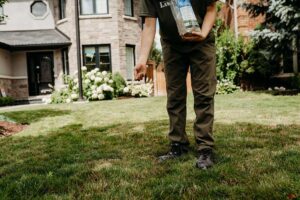 Your grass has these unsightly brown spots that you don’t seem to place a finger on the cause. Maybe you have tried intervening with no success. The truth is, lawn problems can be frustrating, and without proper diagnosis, your innocent interventions may end up aggravating the problem.
Your grass has these unsightly brown spots that you don’t seem to place a finger on the cause. Maybe you have tried intervening with no success. The truth is, lawn problems can be frustrating, and without proper diagnosis, your innocent interventions may end up aggravating the problem.
So, what causes brown spots on grass and how can you fix it?
Different problems can lead to this problem, but some common causes include; pest infestation, dog urine, disease (fungus), foot traffic, and chemical burns.
Here’s how to fix it the first three.
1. Pest infestation
The most common pest responsible for causing brown spots on lawns are grubs. These are white beefy insects that mostly appear coiled in a c-shape. They feed on the roots of the grass, thereby depriving the leaves of a means to access water and nutrients from the soil. As a result, the grass withers and dies.
To find out if they are the cause of the problem, rake out the dead grass on the brown spot and dig the soil to check them.
If they are present, apply nematodes (most effective when applied in July or August) to kill them as well as prevent future infestation. Then reseed the spot(s) or patch with sod.
2. Dog Urine
If you notice that your grass has round brown spots with dark-greenish outer rings, chances are your dog has been relieving itself on the lawn. Dog urine contains high amounts of nitrogen that burn the grass leading to browning.
You can fix this problem by raking out the dead grass and applying a fertilizer treatment (sulphur) to the patch to restore the soil’s PH. A soil test kit should be able to tell once the soil attains its optimal PH, which should be about 6.5. Then you can reseed or patch the spot with sod and nurture the grass to grow.
To avoid repeat cases, ensure you designate areas for your dog to pee.
3. Fungus
Poor lawn maintenance, like over-irrigation, water stagnation, etc. poor air circulation due to overlying objects, and sometimes extreme weather conditions, lead to an outbreak of fungus, which causes brown spots on grass.
However, the disease can be treated by applying a fungicide to the affected areas. This should be followed by proper lawn maintenance to ensure uptake of nutrients and to normalize growth.
A good lawn maintenance regime should involve;
- Regulating irrigation to the recommended weekly water administration
- Addressing low-lying spots on the lawn where water is likely to stagnate
- Mowing the grass to the recommended height on a regular basis
- Dethatching to avoid depriving the roots of water
- Aerating periodically to boost air circulation
- Applying the recommended fertilizer measurements
- Clearing debris, leaves, and other solid objects from the lawn
- Treating brown spots early
In most cases, a proper lawn care regime can help restore the lawn to its lush, green bounce, regardless of the cause. However, if the problem is severe, it can lead to permanent damage to your lawn. That’s why it’s important to consult a lawn specialist whenever your grass has brown spots for proper diagnosis and treatment.
Even with straightforward causes like pest infestation, dog urine, and fungus outbreak, it’s good to work with a specialist to help administer the treatment in the recommended manner.
If you’re within southern Ontario and in need of a lawn care specialist, then you’re in the right place. Whether it’s grass brown spots troubling you or you need an expert for your general lawn maintenance, contact us.